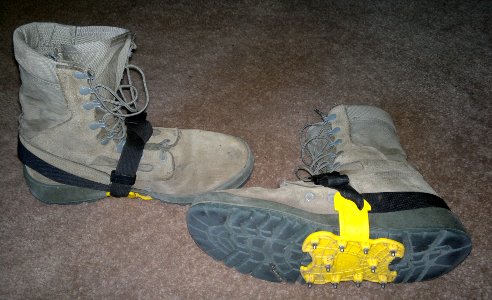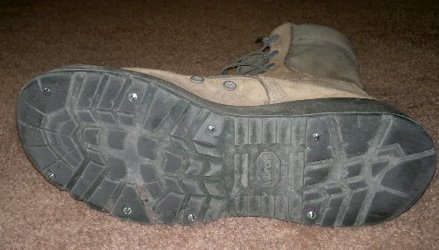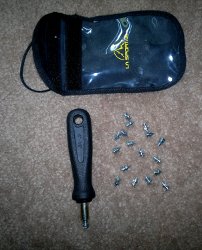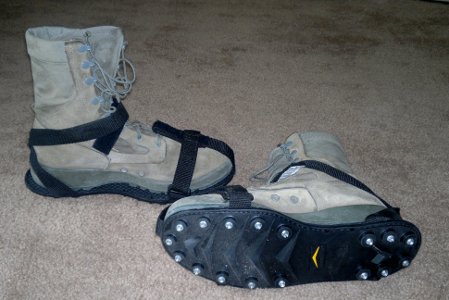Footwear
All content copyright © 2010-2024 Frank Revelo, www.frankrevelo.com, United States copyright office registration number TX-7931345
Purpose of footwear
The purpose of shoes and other footwear is to protect the feet from abrasion and cold, in the same way that gloves or mittens protect the hands. Neither feet nor hands need "support". Support for all parts of the body is naturally provided by the bones and muscles of the body, provided the latter are properly developed. Fallen arches, bunions, excessive pronation and similar foot problems are almost always the result of improperly developed muscles in the feet and lower leg, in the same way that pot bellies, hunched backs and slumped shoulders are the result of improperly developed muscles in other areas of the body. Trying to permanently "support" the feet with arch supports and similar contraptions is as foolish as trying to "support" a pot belly with a corset. On the other hand, temporarily using orthotics as part of the process of correcting poorly developed feet does make sense.
Aside from arch supports and insoles, which can be discarded, the biggest problem with most footwear is tightness in the toe area. In bad cases, this tightness causes bunions and Morton's neuroma. In milder cases, it merely causes blisters between the toes. The second problem is looseness at the heel, which causes rubbing and blisters. It is also possible to have excessive tightness rubbing at the top of the foot, causing tendonitis ther, and there are probably some other ways in which footwear can be ill-fitting that I have overlooked. The bottom line is that proper fit is by far the most important factor in choosing footwear. Any shoe or boot which fits properly should work fine, assuming the feet are properly developed and the gait is proper. Once proper fit is obtained, the only functional differences between shoes concern weight, durability and features that give more or less protection from the elements.
Running shoes
Following Ray Jardine's recommendation, I originally hiked in running shoes and trail runners. But these tend not to last very long (only 1000 trail km for the lighter weight versions), due to the fabric tearing. I was hiking then mostly in Europe, and found it difficult to find replacement shoes that were wide enough in the toe area. When I hiked in shoes that weren't sufficiently wide, I got terrible blisters.
My last two pairs of trail runners were as follows:
- Hi-tec Dakota trail runners, size 11, medium width. The sole on this particular model is not particularly durable, but the front was roomy (at least after removing the insole) and soon stretched enough to be fully comfortable. 810 grams for both shoes (after much of the sole had been worn off and the insoles removed, they were probably slightly heavier when new).
- Salomon trail runners, size 11, medium width. These were too narrow at the front and caused horrible blisters, but eventually stretched enough to be bearable. 985 grams for both shoes (after much of the sole had been worn off and the insoles had been removed—they were probably slightly heavier when new).
Sandals
Because of problems with getting replacement running shoes, I tried hiking exclusively in sandals, mainly the original Teva Hurricane brand, because these are fairly easy to replace with an identical model and are wide in the toe area. The big problem with sandals, which other people have also encountered, is heel cracks due to dryness. Humans evolved in the savannas of Africa, where it is hot and dry most of the year, and of course we evolved walking barefoot, and many humans today still walk barefoot or in leather sandals in hot and dry parts of the world, and yet they don't get heel cracks, so why are people in the developed world who wear sandals so prone to heel cracks? Two explanations have been suggested. First, it takes time for the body to adjust to walking in sandals or barefoot in hot and dry environments. With time, oil production in the heels will increase, and the heel cracks will stop. Second, rubber sandals with a heel cup reduce the production of oil, whereas primitive leather sandals, which lack a heel cup, and barefoot walking do not. So the solution would be to use a different model of sandals, which lacks a heel cup. Though I walked for years in sandals, my oil production never increased to the point of eliminating the heel cracks, so I have my doubts about explanation one. And I never found rubber sandals without a heel cup, so I couldn't test explanation two. Leather sandals are not an option in Europe in the spring, because the outdoors is so wet then in Europe.
I eventually gave up on sandals because they don't provide protection in snow (though it is possible to combine sandals and neoprene socks for snow travel). Also, my last pair of sandals caused me to trip several times on steep descents, and I decided they were a potential danger. With respect to sandals, my best results have been with Teva Hurricane model 2, size 11 (about 600 grams per pair). The pair that caused me to trip was Teva Hurricane model 3, size 10 (540 grams per pair). Either the change in design between model 2 and model 3, or else the size change from 11 to 10, is what caused the sandals to trip me up, because the older Tevas didn't have this problem. Another good type of hiking sandals is Chacos, but these are heavier than Tevas and the strap is very fragile because it is made of light polypropylene instead of heavy nylon, and thus can be cut on rocks very easily. And I have used other sandals, but all of these had problems. The following is a list of criteria I used for choosing hiking sandals:
- Avoid leather sandals, since these will rot in outdoor conditions other than the desert.
- Avoid sandals which will rub the skin raw when wet. Cheap river sandals are designed to be worn under wet conditions and so normally don't have this problem, whereas many fancy outdoor sandals will rub the skin off the top of the feet and leave the wearer crippled if worn under wet conditions, regardless of how comfortable they may feel when dry.
- Avoid sandals whose bottom soles lack traction for wet slippery surfaces. Note that the feet will be slipping around the sandals themselves when wet, so it is better not to compound the problem by having the sandals themselves slip excessively.
- Avoid sandals with quick-release fasteners, since these can break. Teva Hurricanes use hook-and-loop, which is much more reliable, though it sometimes picks up crud outdoors (especially in grasslands). Sturdy ladder-locks are probably the best fasteners, but only if the straps are of heavy nylon.
- Avoid sandals (such as Chacos and certain models of Tevas) which use other than sturdy nylon straps. Thin polypropylene straps can be easily cut by rubbing against sharp rocks in the mountains (I speak from experience).
- Avoid sandals whose straps are merely glued between the top and bottom soles, since these can pull out when subjected to strong forces, such as walking downhill when the sandals are wet. Some Teva models and lots of cheap model sandals are constructed this way. Teva Hurricanes and Chacos run the straps all the way from one side to the other, between the top and bottom soles, and thus the straps are unlikely to pull out, unless the force is such as to rip the top sole apart.
- Avoid sandals with flimsy bottom soles which will wear down quickly under use. Teva Hurricanes will last at least 1500 km on rough terrain before the sole wears through. (I wore one pair on a 1000 km Pyrenees traverse, preceded and followed by at least another 1000 km in the lowlands, for a total of over 2000 km.) Chacos have even more durable soles.
- Avoid sandals which don't have some sort of anti-microbial treatment in the topsole. If sandals nevertheless start to smell, soak them in a strong solution of white vinegar or bleach for a few minutes, then rinse. If necessary, coat with baking soda (bicarbonate of soda) to get rid of any residual vinegar/bleach smell.
- Avoid sandals with neoprene padding on the straps, since this lacks anti-microbial treatment and hence tends to stink after a while. Teva Hurricanes have such neoprene padding on the heel strap only.
- Avoid sandals which don't allow the toes (especially the small toe) to spread out properly.
- Be wary of sandals which have enclosed toes or ridges along the sides which prevent rocks from being easily shaken out. I say be wary rather than avoid, since this may or may not be a problem, depending on other factors. Keen brand sandals have enclosed toes. I haven't yet used Keen sandals.
- Avoid sandals with seams or connectors which sit directly on top of tendons, such as the tendons on top of the foot, as this can cause inflamation of the tendon.
- Avoid flip-flops, since these are likely to fall off while fording a river or rock climbing.
Barefoot
I also experimented, again per Ray Jardine's recommedation, with barefoot hiking. This was definitely an interesting experiment and I recommend it highly myself, mainly as a way of getting in touch with how the feet operate, and fully developing the muscles and tendons. Barefoot hiking offers even less protection than sandals, and I had quite a few nasty accidents while learning this lesson. It takes a minute or so, after removing the shoes, for the nervous system to adjust to being barefoot rather than shod, and until this adjustment is complete, there is a great danger of injury. Once, for example, I took off my shoes and immediately proceeded forwards. On my first step, I swung my foot directly into a rock and broke the nail of the big toe. What had happened is that my nervous system hadn't yet adjusted to the difference in weight between being barefoot and being shod, so that I misjudged the distance. Another time, I slipped and fell while walking barefoot. In order to protect my knees and my hands, I collapsed and turned as I fell, so that my pack took the impact of my upper body, while my feet extended to keep me from slipping down the slope. This would have worked fine with shoes. But because I was barefoot, I ended up badly tearing the skin on the top of my foot. Another time, I was running in the grass while barefoot and stepped on a fragment of metal fence pole that was sticking about an inch out of the ground. And, of course, I often got splinters and thorns in my feet while hiking barefoot.
Like I said, walking barefoot was an interesting experiment. However, there are also good reasons why humans developed sandals, shoes and boots.
Boots
After giving up sandals, I began experimenting with boots, but had all sorts of problems. Most hikers have a a very unrealistic understanding of both their own body and the outdoors, and the boot makers pander to this misunderstanding. In addition to trying to "support" the foot and having narrow toe areas, the other primary failings in most boots are waterproofing, which makes the boots too hot for summer use, and lack of durability. That is, most hiking boots are made for people with weak and crippled feet (collapsed arches and pushed-together toes) who are terrified of getting wet feet and who hike infrequently enough that durability is not an issue.
Examples of common durability problems:
- Sole comes unglued from leather upper. Very frequent failing of cheaply made boots, either because the glue is cheap, or the glue is poorly applied, or not enough glue is used.
- Upper tears because it is made of thin leather or thin fabric.
- Outer sole tears because it is made of soft rubber. Soft rubber gives better traction than hard rubber, which make be why some boot makers choose soft rubber.
- Goretex waterproof-breathable liner tears, so now the boots are neither waterproof nor breathable, but a bastard combination of the worst features of both. Water from outside can leak in, but perspiration from inside cannot get out.
Even when new, boots with a Goretex waterproof-breathable liner are something of a disaster under 3-season hiking conditions. First, they breathe poorly, and the result is hot and damp feet, which is recipe for blisters, fungus infections and stink. Second, water that leaks in from the top, due to rain running down the legs or from crossing deep streams, can't get out. So the boots have to be removed to drain them.
The best hiking boots are those with lightweight fabric uppers. That is, no waterproofing. But even these often have durability problems, which is why I eventually turned to military boots. Discussion continues here.
Socks
Socks should not be an afterthought, but rather should be considered as an integral part of the footwear system. Foolish economy with respect to socks is as bad as foolish economy with respect to shoes or boots. To avoid problems, decide on the sock you will wear before you test shoes or boots for sizing, then wear that sock exclusively thereafter.
Heavyweight wool socks are warm when dry, but this warmth is not necessary other than in winter, since the feet generate plenty of warmth when moving, provided circulation is not restricted. If they get wet, heavyweight wool socks absorb huge amounts of water, weigh a ton and take forever to dry—and yet it is inevitable that socks will eventually get wet outdoors. Thus the best solution is a lightweight sock.
Originally, I used Vermont Darn Tough Micro Crew Cushion wool/nylon socks (size large, olive color, 67% merino wool, 33% nylon, 75 grams per pair), which can be ordered from Campmor. These socks are very comfortable, even when wet, and reasonably durable. My experience is that each pair lasts about 1000 trail km, or approximately a month at 30 trail km/day when worn with Belleville boots. Smartwool makes similar socks, which other people recommend but which I have not tried myself.
Later, I switched to 100% nylon dress socks because one of my boots felt a bit tight (either manufactured slightly tight, of my feet have grown a bit, or the boots shrunk due to drying in the sun) and nylon socks are thinner than wool/nylon. Nylon dress socks from Walmart weigh about 40 grams per pair. (There are lighter weight nylon dress socks available, but they don't last long.) The pair I experimented with in 2016 lasted 3 months hiking in Spain (1000 miles / 1600 km), 6 months city use in Reno and Ukraine, 3 months bicycle touring. At the end of all that usage, the socks had only a few small holes near the heels. Compared to wool/nylon socks, nylon dress socks are: lighter weight, less space in backpack (a minor consideration, given how compact even wool/nylon socks are), more durable, less expensive, absorb less water when wet, faster drying. Nylon dress socks are what Ray Jardine recommends and I am also satisfied with them at this point.
I don't often encounter very cold and wet conditions, such as wet snow or any situation where the boots get wet during the day and then freeze solid at night. However, it was very scary the few times I did encounter these conditions in the past, since my feet went numb and stayed numb for several hours, so that I began to worry about frostbite. I might have suffered nerve damage (frostnip) from these experiences, especially in my right foot, though that was many years ago and the nerves seem to have fully recovered since then.
Neoprene socks are probably the best solution for the 3-season hiker for cold and wet conditions. Neoprene socks work on the wetsuit principle. That is, even if water gets inside the sock, such as through the unsealed seams or a hole, the neoprene continues to insulate, and the water inside the sock simply rises to body temperature. Neoprene socks are thus failsafe in the face of holes or water leaking in through the top of the sock when crossing streams. Seirus takes this principle one step further with their Supersock, which is made of 2mm neoprene sandwiched between two layers of nylon jersey, with small holes punched in the neoprene. These holes allow perspiration to evaporate, and thus allow the socks to be used comfortably in conditions near freezing (rather than far below freezing). Neoprene socks without holes would cause the feet to overheat and become soaked in their own perspiration (macerated) in such conditions. Whereas in extremely cold conditions, liquid water is not common, so the holes don't significantly reduce these Seirus socks' insulating power compared to neoprene socks without holes. The Seirus neoprene socks weigh about 125 grams. Because of their thickness, it might be necessary to size boots slightly larger when wearing these socks (10 extra-wide versus 10 wide in my case). I bought my Seirus socks from Campmor, but they are no longer in stock there. Campmor also used to sell a house-brand neoprene sock which was very similar to the Seirus sock, except half the price and slightly lighter in weight (110 grams versus 125 grams for the Seirus socks). Perhaps the Campmor socks use thinner neoprene, though I can't tell from inspection. Both the Seirus and Campmor socks tend to run slightly small, so sizing up is advisable (extra-large size in my case). Cabelas sells a variety of neoprene socks without holes. Neoprene tends to pick up smells when worn directly against the skin (especially the feet), so bring along Mirazyme to clean it and perhaps sprinkle some anti-bacterial foot powder in the socks now and then. I am still experimenting with neoprene socks.
I also experimented with Sealskinz and Rocky-brand goretex socks worn over my normal socks as a way of coping with cold wet conditions, but neither of these solutions is failsafe in the face of holes like neoprene. (Sealskinz consists of a nylon jersey exterior, waterproof-breathable barrier, and fleece liner, and fleece provides even less insulating power than my normal wool socks when wet.) The goretex socks are also very hard to pull on over my regular socks.
Boots with goretex or other waterproof-breathable liner are a poor choice for the 3-season hiker. First, the liner will not last long before the seams tear and start to leak. My estimate would be 300 km maximum before leakage. Second, the liner impedes breathability, which causes the feet to overheat other than in near-freezing conditions. Do not underestimate the amount of heat the body produces when hiking uphill on rough terrain while carrying a backpack. For winter boots, the situation is different. Winter boots are normally waterproofed with a thick layer of grease, to prevent the leather from absorbing moisture, and thus breathability is already compromised. A goretex liner inside the waterproofed leather would act as a second line of defense, even after the goretex began to leak, provided the seams on the goretex didn't line up with the seams on the leather, since seams are where leaks tend to occur. Winter boots should be worn with thick wool socks which extend past the top of the boots, to absorb perspiration and wick it to where it can evaporate.
Traction aids
I try to schedule my hiking to avoid severe ice conditions, and I neither own nor plan to ever carry an ice ax or crampons. But there have been time when I've had to cross short stretches of ice to avoid long detours. For example, both times when I hiked the Southern California portion of the Pacific Crest Trail, there was ice on Fuller Ridge, Mount Baden Powell, and between Kennedy Meadows and Lone Pine. The first time, I had the Grivel Spiders. The second time, I had nothing and did not feel safe. In the future, whenever there is even the remotest possibility of ice, I will be carrying some sort of traction aid, either the Grivel Spiders if I anticipate multiple stretches of ice, or the La Sportiva hobnails if I anticipate few or no stretches of ice, but neverthless want to be prepared.
Grivel Spiders
Unisize, ordered from Campmor. Other than brief usage along the PCT in April, when they worked fine, I lack much experience with these traction aids. The advantage compared to the La Sportiva hobnails is that they can be much more easily put on and removed. 180 grams per pair, including carrying case.

La Sportiva hobnails
Ordered from Summit Hut. I've yet to use these in the field, but I have tried installing and removing them from my boots, and I'm pretty sure they would work as well as the Grivel Spiders, if not better. Big problem is that they can't be easily installed and removed like the Grivel Spiders. If left installed while walking on bare rocky ground, issue of durability comes up. If repeatedly installed and removed, they chew up a bit of the sole each time, and so eventually will cease to screw in securely. Kit includes 18 hobnails (25g), insertion tool (58g) and carrying case (17g), for total of 100 grams. The insertion tool could probably be cut down and the carrying case replaced by something lighter to reduce weight to 80 grams or so, which is less than half the weight of the Grivel Spiders. Space required is also much smaller than for the Grivel Spiders. Thus if ice is not expected, but nevertheless there is the possibility of ice and you want to be prepared, hobnails are the better choice for backpackers concerned about weight and space.


Boots with hobnails inserted, and hobnail kit as shipped.
Homebrew hobnails
Some people screw ordinary hex-head machine screws from the hardware store into their boots or running shoes. If a small screwdriver is used, this could be a lighter weight solution than the La Sportiva hobnails, and also much cheaper. However, ordinary machine screws will not attach nearly as securely to the boots or shoes as the La Sportiva hobnails.
Stabilicers
Size L, ordered from Campmor. These work well in the city, which is where I use them. They are easy to put on and remove, are very stable, and work okay on bare concrete sidewalks and streets. By contrast, the Grivel Spiders work poorly on bare concrete. However, the Stabilicers are very heavy, about 770 grams per pair, and thus unacceptable for backpacking. The screws used in the Stabilicers are ordinary hex-head machine screws.

Yaktrax Pro
Only 155 grams for size L, but I read bad reviews concerning durability. They are also somewhat of a nuisance to put on and remove (I tried them in the store), and I have some doubts about how much traction they add.
Kahtoola Microspikes
Good reviews, but 410 grams per pair for size large, which is too much for backpacking, at least for me.
Camp "6 Punte Light" instep crampons
200 grams, from BackcountryGear.com. Never tried these. Can't think of any advantages compared to Grivel Spiders or La Sportiva hobnails, both of which weigh less.